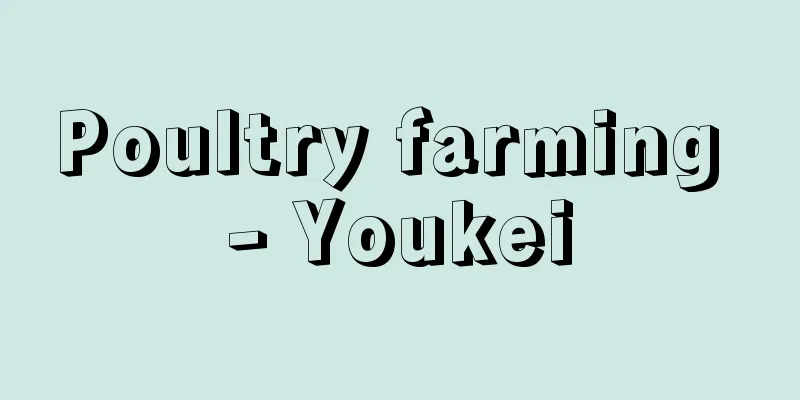Poultry farming - Youkei

|
It refers to raising chickens to use their products such as eggs and meat. Depending on the method of raising, they can be classified as backyard chicken farming, cage-free chicken farming, or cage-based chicken farming (battery chicken farming). Backyard chicken farming is a method of free-ranging chickens in the farmyard of a farmer, and was once common in rural areas of Japan, but in the current poultry farming industry, multi-dimensional cage-based chicken farming and battery-based chicken farming, which can accommodate a large number of chickens in a small area, is common. For breeding chicken production and fattening of meat chickens, cage-free chicken farming, which involves raising chickens on flat ground, is often used. Depending on the purpose of production, chickens can be broadly divided into egg farming and broiler farming, and each of these can be further divided into breeding chicken production and practical chicken farming. [Yoichi Shoda] Feeding methodIn the current poultry industry, both laying hens and broilers are produced as practical chickens by crossbreeding, and three-way or four-way crosses are often used to take advantage of heterosis. Therefore, poultry farms that aim to produce breeding chickens must maintain and breed several highly inbred pure lines as original breeds. Breeding chickens are usually kept on a cage-free farm, and one male is paired with 5-10 females to produce fertilized eggs for use as hatching eggs. Recently, artificial insemination has also been applied. Two different original breeding chickens are crossed to produce original breeding chickens, and a paternal original breeding chicken is crossed with a maternal original breeding chicken to produce a practical chicken (commercial chicken). This is the case of a four-way cross, and if a third line is used as the father of the practical chicken instead of a hybrid, it becomes a three-way cross. The reason why such a complex method is used for practical chicken production is that in order to produce practical chickens, which require a large number of individuals, the mother hens must have high egg-laying ability, and therefore it makes sense to use first-generation hybrids, which are expected to have hybrid vigor, as mother hens. In egg-laying chicken farming, female working chickens produced by breeding chicken producers are purchased and raised to produce eggs for eating. Most of these are run by large-scale companies, and many of them are raised in multi-level cages. This method can be carried out with relatively little capital and a small amount of land, and since the chickens are housed individually in cages, there is little competition between them and feeding is uniform. In some cases, two or three chickens are kept in one cage. In addition, watering, feeding, and removing feces are mechanized, making it easier to manage with less labor, and sanitary management such as disinfection is also easy. On the other hand, however, chickens can become unhealthy due to lack of exercise, and while housing multiple chickens in one cage is more economically efficient, it can also lead to more intense competition, so some people oppose this method from the perspective of animal welfare. One of the advantages of caged chicken farming used to be that it was easy to cull the bad chickens because the performance of each individual chicken could be clearly tracked. However, in recent years, chickens have been bred to have less variation in performance within a flock, so for management reasons, an all-in all-out system is often used, in which the entire flock is brought in at once and culled all at once. In the case of broiler chicken farming, hybrids created by breeding chicken producers are introduced in the same way, and the chickens are shipped as meat chickens weighing about 2.6 kilograms (8.5 weeks old). Broiler chicken farming is usually done in groups on a floor, and the chickens are fed ad libitum and allowed to eat freely. In any poultry farming business, there are various stages including incubation, chick rearing, and adult chicken management, but in some cases each stage is divided into separate tasks, and in other cases the same stage is carried out by the same farmer. (1) There are two methods of incubation: incubation by mother hens and artificial incubation. In the poultry farming industry, artificial incubation is carried out using an incubator. Hatching eggs are incubated in a large, multi-story incubator that can hold tens of thousands of eggs. Many chicken diseases are transmitted through eggs, so disinfection must be done with great care. It is more efficient to keep males and females separate for laying hens and broilers as well, so the sex of day-old chicks immediately after hatching is determined. The fingertip identification method, in which the cloaca is opened with a finger to identify the reproductive protrusions, is widely used, but sex-indicating chickens, whose sex can be determined by the feather characteristics, which are a sex-linked genetic trait, are also bred and used. (2) In chick rearing, day old chicks are raised for 50-60 days before being shipped as mid-career chicks. This is highly efficient but lacks stability, so it is often done as a side job. In artificial rearing, the temperature is kept at 33°C for one week after hatching, then gradually lowered and the temperature is removed after 3-4 weeks. Methods of heating include installing an umbrella-shaped brooder, heating the floor by passing hot water through pipes, and blowing hot air. In an umbrella-shaped brooder, weaker chicks prefer high temperatures, so they are placed close to the heat source, while stronger chicks prefer low temperatures, so they are placed far away, making it rational to choose a place that is just right for each chick. Hygiene management during the brooding period is particularly important, and great care must be taken to prevent diseases. Also, when chicks are raised in groups, they are prone to developing bad habits such as pecking at the bottom and eating feathers. To prevent this, beak trimming is performed. When the chicks are 5-8 weeks old, one-third of their upper beaks are cut off using an electrically heated beak trimmer. In areas with severe winters, the comb can become frostbitten and have a detrimental effect on egg-laying, so it is a good idea to perform decapitation, in which the comb is cut off when the chicks are first hatched. (3) When managing adult egg-laying hens, light-lighting is used to increase productivity. Since egg production is affected by day length, lights are turned on in the poultry house during the fall production cutback, and by extending the daylight hours, the timing of molting is changed, increasing the number of eggs laid during the period when egg value is high. Light management is also sometimes carried out during the brooding periods of autumn and winter chicks in order to regulate the age at which chicks first lay. Light-lighting also has the effect of increasing food intake and promoting growth in broiler chicken farming. [Yoichi Shoda] Japan's poultry industryThe fact that chickens have been kept in Japan since ancient times can be inferred from the fact that chickens appear in myths. However, chickens were not kept for meat or eggs as they are today, but mainly for the purpose of announcing the morning, for cockfights to tell fortunes, and for entertainment. Eventually, chickens came to be used for meat and eggs, but their use was very limited at the time due to their low productivity. During the Edo period, chickens were actively improved as pets, and long-crowing chickens such as Totenkou, Koeyoshi, and Tomaru, as well as ornamental chickens such as Onagadori, Minohiki, and Chabo were bred one after another. Consumption of chicken eggs and meat also gradually became more common during the Edo period, and chicken farming began to take place from Western Japan to the Kansai region and Aichi Prefecture. However, it was not until the Meiji era that professional egg production was established, and production areas expanded from Aichi Prefecture to various regions of Tokai, Kanto, Kinki, Chugoku, and Shikoku. There was also a strong passion for genetic improvement of egg-laying ability, and in 1939 (Showa 14) they set a world record of laying 365 eggs in a year. In addition, the discovery of a method for sexing of newly hatched chicks by Masui Kiyoshi and others in 1924 (Taisho 13) also made a great contribution to the poultry farming world. Japan's poultry industry, which was hit hard by the Second World War, saw rapid growth during the period of high economic growth in the 1950s and 60s. Processing-type egg-laying chicken farming, which used imported grains as a feed source, showed rapid growth, and at the same time, broiler chicken production increased dramatically from around 1960. The strong ties between trading companies handling grain imports, the feed industry, and the poultry industry led to the development of an integrated system that covers everything from feed production to chicks, and the processing and sale of chicken meat. As of 1999, Japan's chicken population is 246.99 million (143.05 million layer chickens and 103.94 million broilers), the fifth largest in the world, and in terms of chickens per unit area of cultivated land, it is first, surpassing the Netherlands and South Korea. Egg production also exceeds 2 million tons, and the government is taking measures to curb production due to a lack of growth in consumption. [Yoichi Shoda] "Poultry Farming Encyclopedia" edited by the Poultry Farming Encyclopedia Editorial Committee (1963, Yokei no Nihonsha)" ▽ "The Latest Poultry Farming Handbook" by Yuichi Kimura (1991, Japan Poultry Farming Association)" [Reference] | | | | | | |Chickens|Source: Shogakukan Encyclopedia Nipponica About Encyclopedia Nipponica Information | Legend |
|
鶏卵や鶏肉などの生産物を利用するためにニワトリを飼養することをいう。飼い方によって庭先養鶏、平飼い養鶏、ケージ養鶏(バタリー養鶏)などに区分する。庭先養鶏は農家の庭先に放飼する方法で、かつては日本の農村にも普通にみられたが、現在の産業としての養鶏業では狭い面積に多数を収容できる立体的なケージ養鶏・バタリー養鶏が多く行われている。種鶏生産や肉用鶏の肥育には平地で飼育する平飼いの方式も採用されることが多い。生産の目的によって分類すると採卵養鶏とブロイラー養鶏に大別され、それぞれはさらに種鶏生産と実用鶏飼育に区分される。 [正田陽一] 飼養の方法現在の養鶏業では、採卵鶏もブロイラーも実用鶏として生産に従事するのは交配種であり、雑種強勢(ヘテローシス)を利用するための三元交雑種か四元交雑種が用いられることが多い。そのため種鶏生産を目的とする養鶏場では、近交度の高い純粋な系統をいくつか原原種として維持し繁殖しなければならない。種鶏は平飼いで飼われるのが普通で、種卵としての有精卵をとるために、雌5~10羽に対して雄1羽を配する。最近では人工授精も応用される場合もある。二つの異なる原原種鶏が交配されて原種鶏が産出され、父系の原種鶏と母系の原種鶏が交配されて実用鶏(コマーシャル鶏)が生産される。これが四元交雑種の場合であり、実用鶏の父に雑種を使わず第三の系統を使えば三元交雑となる。実用鶏生産にこのような複雑な方式をとるのは、多数の個体を必要とする実用鶏を生産するには母鶏の産卵能力が高くなければならず、そのため雑種強勢の期待できる一代雑種を母鶏とするのが合理的なためである。 採卵養鶏では、種鶏生産業者の生産した実用鶏の雌を購入・飼育して食卵を生産する。大規模な企業経営のものが多く、立体式のケージ養鶏が多い。この方式は比較的少ない資本、狭い土地で行えるうえ、ケージに個別に収容するためニワトリどうしの競合が少なく、採食も均一になる。2、3羽を1ケージに入れるケースもある。また給水・給餌(きゅうじ)・除糞(じょふん)が機械化されるので省力管理が行いやすく、消毒などの衛生管理も容易となる利点がある。しかし反面、ニワトリが運動不足から健康を損なうこともあり、かつ1個のケージに複数を収容した場合には経済上の効率はあがるが、競合がいっそう激しくなることもあるので、動物の福祉の面から反対する者もある。ケージ養鶏の一つの利点として、かつては個体ごとの成績がはっきりと把握できるので駄鶏淘汰(とうた)が容易である点があげられていたが、最近では群としての能力の変異が少なくなるよう育種されているので、管理上から全群を一時に導入し一斉に廃鶏にするオールイン・オールアウト方式all-in all-out systemがとられることが多くなっている。 ブロイラー養鶏の場合は、やはり同様に種鶏生産業者の作出した交雑種を導入し、体重2.6キログラム(生後8.5週)前後の食用鶏として出荷する。ブロイラー養鶏では平飼いの群飼が普通で、餌(えさ)は不断給餌で自由に採食させる。 いずれの養鶏業でも孵卵(ふらん)・育雛(いくすう)・成鶏管理の各段階があるが、それぞれを分業する場合もあり、一貫して行う場合もある。 (1)孵卵には母鶏孵化と人工孵化の二つがあるが、産業としての養鶏業では孵卵器を用いた人工孵化が行われている。何万個も収容できる立体式の大型孵卵器で種卵を孵化させる。ニワトリの病気のなかには介卵感染をするものも多いので消毒には十分注意する必要がある。採卵鶏の場合はもちろん、ブロイラーも雌雄を分けて飼うのが効率的であるため、孵化直後の初生雛(びな)は雌雄鑑別を行う。指で総排出腔(こう)を開き生殖突起を見分ける指頭鑑別法が広く行われているが、一方で伴性遺伝形質である羽性によって性別がわかる自己性表示鶏も育種され利用されている。 (2)育雛養鶏は、初生雛を50~60日育成して中雛(ちゅうびな)として出荷する。効率は高いが安定性に欠けるので、兼業する場合が多い。人工育雛では孵化後1週間は33℃の温度を保ち、以後徐々に温度を下げて3~4週で廃温する。給温の方法には、傘形の育雛器を設置したり、温水をパイプに通す床面給温、温風による送風暖房などがある。傘形の育雛器では弱い雛は高温を好むので熱源に近く、強い雛は低温を好むので遠く、それぞれ適温のところを選ぶので合理的である。育雛期の衛生管理はとくに重要であり、病気の予防には万全の注意を払う必要がある。また雛を群飼で育成する場合、尻(しり)つつきや食羽などの悪癖が発生しやすい。これを防ぐために断嘴(だんし)が行われる。生後5~8週で電熱を利用した断嘴機で上嘴(くちばし)の3分の1を切り取る。冬季の寒さの厳しい土地ではとさかが凍傷にかかり産卵に悪影響を及ぼす場合もあるので、初生時にとさかを切り落とす断冠を実施するとよい。 (3)採卵鶏では成鶏を管理する場合、生産性を高めるために点灯養鶏を行う。産卵は日長により影響を受けるので、秋の減産時に鶏舎内に点灯し、日照時間を延長することによって換羽の時期を変更し、卵価の高い時期の産卵数を増加させる。また光線管理は雛の初産日齢を調節する目的で秋雛・冬雛の育雛期に行われることもある。ブロイラー養鶏においても点灯養鶏は採食量を増し発育を促進する効果がある。 [正田陽一] 日本の養鶏業わが国に古くから養鶏が行われていたことは、神話のなかにもニワトリが登場することからも推察される。しかしこのニワトリは現在のように卵や肉を食用にするために飼われていたのではなく、主として時を告げる報晨(ほうしん)を目的として、また吉凶を占う闘鶏や娯楽のための闘鶏の目的で飼育されていたと考えられる。やがて肉や卵が食用に供されるようになったが、生産性の低い当時のニワトリではその利用はごく限られたものであった。江戸時代には愛玩(あいがん)鶏としての改良が盛んに行われて、長鳴鶏の東天紅(トウテンコウ)・声良(コエヨシ)・唐丸(トウマル)、観賞鶏としての尾長鶏(オナガドリ)・蓑曳(ミノヒキ)・矮鶏(チャボ)などが次々と作出されている。鶏卵・鶏肉の消費も江戸時代にはしだいに一般化し、西日本から関西地方、愛知県にかけて養鶏が行われるようになった。 しかし鶏卵生産の専門経営が成立したのは明治時代に入ってからで、愛知県を中心として、東海・関東・近畿・中国・四国の各地方へと産地は拡大した。産卵能力の遺伝的改良への熱意も高く、1939年(昭和14)には世界に先駆けて年間365卵を産卵した記録をつくっている。また1924年(大正13)の増井清らの初生雛雌雄鑑別法の発見も、養鶏界への偉大な貢献を果たした。 第二次世界大戦で大きな打撃を被った日本の養鶏業は昭和30年代の日本経済の高度成長期に飛躍的に発展した。輸入穀物を飼料源とした加工業型の採卵養鶏が急速な伸びを示し、同時に1960年ごろからブロイラー養鶏がその生産を急激に増大させた。穀物の輸入を扱う商社・飼料産業・養鶏業の強固な結び付きが、飼料生産から素雛(もとびな)を経て、鶏肉の加工処理・販売までを統合する体制(インテグレーション)を発展させた。 1999年(平成11)現在、日本のニワトリ飼養数は2億4699万羽(採卵鶏1億4305万羽、ブロイラー1億0394万羽)、世界第5位の飼養羽数で、耕地単位面積当り羽数ではオランダ、韓国を押さえて首位にたっている。鶏卵の生産も200万トンを超え、消費の伸びがないため政府は生産抑制策をとっている。 [正田陽一] 『養鶏大事典編集委員会編『養鶏大事典』(1963・養鶏之日本社)』▽『木村唯一著『最新・養鶏ハンドブック』(1991・日本養鶏協会)』 [参照項目] | | | | | | | | |出典 小学館 日本大百科全書(ニッポニカ)日本大百科全書(ニッポニカ)について 情報 | 凡例 |
<<: Cost of the performance - Yogekiryo
Recommend
Antigone
(Antigone) [1] Daughter of Oedipus, the king of Th...
Locustella
…General term for birds of the Locustella genus i...
Head and spine sword - Kabutsuchi no Tachi
A type of sword fitting from the Kofun period. Th...
Audio equipment - Audio listening
The basis of audio is to enjoy listening to sound,...
Wafnar, J.
… In the 17th and 18th centuries, citizen perform...
Space life
...the study of the medical, psychological, physi...
lady's eardrop
...The flowers come in a wide variety of colors a...
Sud-Aviation
…Its official name is Société nationale industrie...
Isuka (red crossbill) - Isuka (English spelling) red crossbill
A bird of the family Fringillidae (illustration) i...
Neighboring relations - Kinrinkankei (English spelling)
Everyday social relationships that are formed as a...
Penile cancer
A type of skin cancer that develops on the penis, ...
Eizboll Constitution - Eizboll Kenpo
The Norwegian Constitution was established in 1814...
Castile Bras - Castile Bras
...Today, when people generally talk about tonali...
Gakusando Inpu - Gakusando Inpu
…The Qing Dynasty had Wu Guanjun’s 10 volumes of ...
Izumoya Magobee - Izumoyamagobee
…In 1830, Shimazu Shigehide ordered the governmen...









